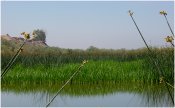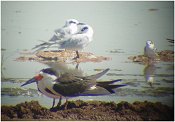Salton Sea
Sept 29,
2001
Sunny & Hot, 85-105
Henry, Suzanne &
Adriana, took a fine half-day trip to survey the New River Ponds and
check out Red Hill Marina & the Bubbling Mud Pots.
79 species total (list follows at end page)

Click on
thumbnail pictures for full-sized shots.
Our first good birds were a pair
of cock Ring-necked Pheasants just east of Holtville. Along the
same canal bank we got some fine looks at our first of about 15
Burrowing Owls.

Common Moorhen
|
The Imperial Ponds
were loaded with a variety of bird life, including Cinnamon Teal, moorhens,
dozens of egrets, two Black-crowned Night Herons, a pair of Forster's Terns, seven Black Phoebes,
a Loggerhead Shrike, and a
Willow Flycatcher!
|
|
The numbers at the Brawley Ponds weren't as productive, but we
still got very nice views of stilts, a Greater Yellowlegs, Least Sandpipers,
phoebes, and Song Sparrows.
|

Brawley Ponds
|
|

Black-necked Stilt
|
After a quick snack, we meandered to Red
Hill Marina, where the shorebird numbers were very impressive. The
ponds on the east side of the access road had hundreds of Black Terns,
stilts, and avocets.
|
|
A nice surprise were these Black Skimmers, which feed in a
very unique fashion. They fly along the surface of the water with
their beak wide open, the lower mandible slicing through the water and
"skimming" off insects.
|

Black Skimmers
|
|
|